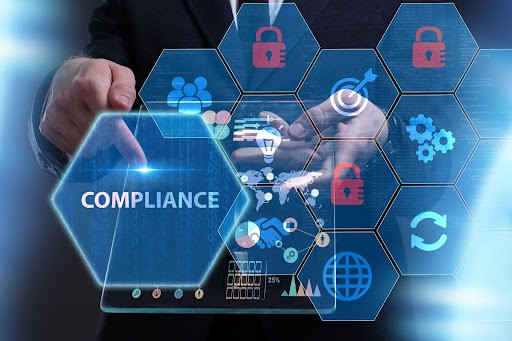Data is among the most valuable assets for businesses across any industry: financial offices, law firms, educational institutions, healthcare, engineering firms, retail businesses — any sector/niche/industry.
Organizations rely on data to drive decision-making and gain a competitive edge, from customer information to proprietary research. However, with cyber threats constantly at the forefront, maintaining your edge means complying with stringent regulations.
One of your utmost priorities as a modern business should be ensuring data security compliance. Let’s review what data security compliance is.
What Is Data Security Compliance?
Data security compliance refers to your organization’s measures and practices for protecting sensitive information and adhering to relevant industry regulations and standards.
Whether you’re protecting personal data via protection laws like Europe’s General Data Protection Regulation (GDPR), healthcare’s HIPAA, or industry-specific mandates, compliance requirements vary depending on three factors:
- Your geographic location
- Your industry sector
- The type of data you collect and process
Unfortunately, navigating the complex data security compliance landscape is often daunting for businesses. It becomes more intimidating as regulations evolve and become stricter.
However, your organization can develop robust compliance strategies to safeguard your data and mitigate regulatory risks effectively. It all starts with understanding fundamental principles and best practices.
Let’s review the steps you should take to ensure your business is data security-compliant.
[Related: 11 Data Security Metrics IT Professionals Use To Measure Network Defense]
1. Know Your Regulatory Landscape
The first step in achieving data security compliance is understanding your business’s regulatory landscape. For example, there are certain states that enforce consumer data privacy laws — New York happens to be one of the twelve that do!
Then conduct a thorough assessment to identify other applicable regulations and industry standards. To know which ones are relevant to you, learn how your data is collected and where it’s stored and processed in your jurisdiction and industry sector.
If you’re unsure how to do this, it’s best to contact IT professionals like CMIT Solutions of Rochester—we’re experts, after all!
2. Classify and Prioritize Data
Not all data is created equal … so not all data requires the same level of protection! (However, you should aim to protect all of your data, no matter its importance or scale.)
Classify your data based on its sensitivity, value, and regulatory requirements to get started. Then, prioritize protecting high-risk data such as the following:
- Personally identifiable information, like social security numbers
- Financial records, like invoices
- Intellectual property, like patents
Ensure you comply with regulations relevant to your industry, especially those involving high-risk data.
3. Implement Security Controls
Deploy comprehensive security controls to protect your data against unauthorized access, disclosure, and misuse.
These security controls range greatly and may include multiple approaches:
- Encryption
- Access controls
- Multi-factor authentication
- Network segmentation
- Regular security audits
It’s also essential to ensure your security measures align with industry best practices and regulatory requirements.
[Related: 11 Data Security Metrics IT Professionals Use to Measure Network Defense]
4. Establish Data Governance Policies
Develop and enforce data governance policies that outline clear guidelines and procedures for each step:
- Data handling
- Storage
- Retention
- Disposal
Implement robust data management processes to ensure compliance with regulatory mandates. These include data subject access requests (DSARs), consent management, and data breach notification requirements.
Here’s a closer look at what these are and what they entail.
DSARs
DSARs refer to requests that people make — known as data subjects — to access, review, and potentially receive copies of the personal data that an organization holds about them.
People typically make these requests under data protection laws like the GDPR or similar jurisdictional regulations.
DSARs empower people to exercise their rights to transparency and control over their data. They also allow people to understand how businesses process their data thoroughly and to ensure its accuracy and legality.
Consent Management
Consent management involves the processes and mechanisms organizations implement to obtain, record, track, and manage people’s consent for collecting, using, and processing their personal data.
Under data protection regulations like GDPR, organizations must obtain explicit and informed consent from people before processing their personal data for any purpose.
However, all of this is very difficult to track manually, which is where consent management platforms come in. They help you keep your consent records up-to-date and organized and include key details including:
- When organizations obtained consent
- Why people gave consent
- Any subsequent changes or withdrawals of their personal consent
Data Breach Notification Requirements
Data breach notification requirements mandate that organizations notify any /all stakeholders whom a data breach affects (customers, regulatory authorities, etc.) as quickly as possible.
The bottom line is that people should know when unauthorized persons potentially access or share their data.
Data protection laws and regulations worldwide carry these requirements, including GDPR, HIPAA, and sector-specific areas.
Additionally, data breach notification laws typically set time frames by which organizations must notify affected parties. Those notifications also have to include further details:
- The nature of the breach
- The type of compromised data
- Recommended steps for people to protect themselves from possible harm
Complying with data breach notification requirements is critical to prevent breaches from having a more severe impact. They also help you avoid penalties and fines from regulatory authorities and ensure your business maintains trust with clients and partners!
Note. Take a look at data breach laws by state so you remain compliant wherever your business operates.
5. Conduct Regular Risk Assessments
Conduct regular risk assessments and vulnerability scans to stay proactive in identifying and mitigating data security risks. This is a must and helps you identify any weaknesses or gaps.
Afterward, you can take corrective actions to strengthen your security posture and stay ahead of emerging threats. You can also adapt your risk management strategies accordingly.
6. Provide Employee Training and Awareness
It’s not news that humans are prone to making mistakes. Unfortunately, human error is a leading cause of data breaches.
This makes it vital to educate your employees about their roles and responsibilities in safeguarding data and complying with regulatory requirements.
Offer comprehensive training programs on data security best practices and privacy principles, even if you think your employees know them. Humans are also inherently forgetful, so it’s critical that repetitive training is employed. A good rule of thumb is to run quarterly training on rotation. That way, the key components will be perpetually top of mind and ready to use!
Additionally, consider distributing regulatory compliance classes or tests to your team. Fostering a culture of accountability throughout your organization encourages employees to perform responsibly. This responsibility is significant in protecting clients and maintaining data security compliance.
7. Monitor and Audit Compliance
Establish straightforward, concrete ways to monitor and audit compliance with data security regulations and internal policies.
Consider implementing logging and monitoring tools to track data access and usage.
These tools can also detect suspicious activities that spark potential security incident investigations. However, remember to conduct compliance audits and assessments as much as possible despite having these tools. Doing so will help you better adhere to regulatory requirements and avoid facing fines and other penalties.
8. Stay Updated and Adaptive
The data security regulatory landscape is constantly evolving, especially globally. This presents challenges for businesses that operate globally or engage in international trade.
In July 2023, the European Commission strengthened the GDPR, ensuring more robust enforcement for cross-border data security compliance cases.
Stay informed about changes to regulations, industry standards, and emerging cybersecurity threats. Then, routinely update your compliance strategies and security controls.
As a result, you can address those new challenges effectively and maintain compliance with shifting requirements.
[Related: To Outsource IT or Hire In-House]
Contact CMIT Solutions of Rochester
Achieving data security compliance is multifaceted and requires a proactive approach. By staying informed and committing to best practices, your organization can confidently navigate its ins and outs.
But when you’re a busy company, keeping up with changing compliance rules while monitoring your data isn’t always feasible.
CMIT Solutions of Rochester takes the work off your hands. Our skilled IT professionals are dedicated to making your company more secure with its data so your clients remain satisfied.
Contact us today to get started — we’re ready when you are!




